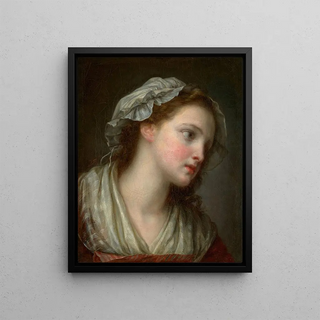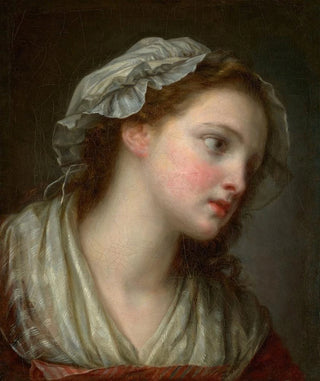Art print | Girl with Bonnet - Jean-Baptiste Greuze


View from behind

Frame (optional)
In the rich and diverse universe of art, some works stand out for their ability to capture profound human emotions and transcend time. "Fille au bonnet" by Jean-Baptiste Greuze is one of those iconic pieces that, through its penetrating gaze and delicate expression, invites us to explore the subtleties of its subject's inner life. This artwork, created in the 18th century, demonstrates Greuze's skill in blending realism and sensitivity, offering a window into the human soul. The art print Fille au bonnet - Jean-Baptiste Greuze allows us to rediscover this masterful piece while adding a touch of elegance to our interiors.
Style and uniqueness of the work
Jean-Baptiste Greuze's style is characterized by an intimate approach and meticulous attention to detail. In "Fille au bonnet," the young woman, wearing a delicate bonnet, is depicted in a natural pose that evokes a certain softness. The carefully orchestrated play of light and shadow highlights the fine features of her face, while pastel colors confer a calming atmosphere to the overall scene. Greuze excels in portraying emotions, and this painting is no exception. The gaze of the young girl, both thoughtful and dreamy, seems to tell a story, prompting the viewer to reflect on her thoughts and aspirations. This ability to capture the very essence of his subjects is what makes the work so singular and timeless.
The artist and his influence
Jean-Baptiste Greuze, an emblematic figure of the 18th century, managed to establish himself in the art world thanks to his unique style and humanist vision. Raised in a context where neoclassicism was beginning to dominate, Greuze chose to focus on the representation of emotions and scenes of everyday life, thus moving away from the rigid conventions of his time. His influence is evident in the development of portraiture and genre painting, where he paved the way for many artists who followed. Through his works, Greuze succeeded in establishing a dialogue between art and sensitivity

Matte finish

View from behind

Frame (optional)
In the rich and diverse universe of art, some works stand out for their ability to capture profound human emotions and transcend time. "Fille au bonnet" by Jean-Baptiste Greuze is one of those iconic pieces that, through its penetrating gaze and delicate expression, invites us to explore the subtleties of its subject's inner life. This artwork, created in the 18th century, demonstrates Greuze's skill in blending realism and sensitivity, offering a window into the human soul. The art print Fille au bonnet - Jean-Baptiste Greuze allows us to rediscover this masterful piece while adding a touch of elegance to our interiors.
Style and uniqueness of the work
Jean-Baptiste Greuze's style is characterized by an intimate approach and meticulous attention to detail. In "Fille au bonnet," the young woman, wearing a delicate bonnet, is depicted in a natural pose that evokes a certain softness. The carefully orchestrated play of light and shadow highlights the fine features of her face, while pastel colors confer a calming atmosphere to the overall scene. Greuze excels in portraying emotions, and this painting is no exception. The gaze of the young girl, both thoughtful and dreamy, seems to tell a story, prompting the viewer to reflect on her thoughts and aspirations. This ability to capture the very essence of his subjects is what makes the work so singular and timeless.
The artist and his influence
Jean-Baptiste Greuze, an emblematic figure of the 18th century, managed to establish himself in the art world thanks to his unique style and humanist vision. Raised in a context where neoclassicism was beginning to dominate, Greuze chose to focus on the representation of emotions and scenes of everyday life, thus moving away from the rigid conventions of his time. His influence is evident in the development of portraiture and genre painting, where he paved the way for many artists who followed. Through his works, Greuze succeeded in establishing a dialogue between art and sensitivity






